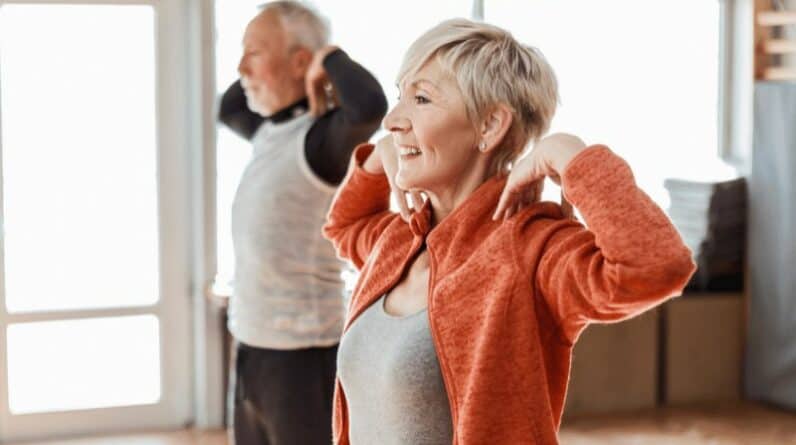
Dementia Discovery That is Leaving Doctors Speechless (Try This Tonight)
Better than Morphine For Joint Pain… Yet Safer Than Aspirin?
Retire With Freedom. Start Earning Extra Cash Today.
Over 50 Full Body Workout – Here are Some Ideas
People over 50 need to continue exercising for the sake of their mental and physical health. As people age, they typically experience a decline in both muscle mass and bone density — which can lead to risk factors like heart disease, arthritis, osteoporosis, obesity, erectile dysfunction, depression, and more. The first step is making up your mind about committing to an exercise routine. Choose one that you will enjoy enough to sustain until you reach your goals or run out of time.
Once you have found something you enjoy, the next step is setting up an appropriate workout area. Don’t try to cram everything into a single room or into a narrow space. You need space to stretch, move around and even do some aerobic activity, if possible. Install equipment you need for your chosen exercises, such as free weights and adjustable benches for weight training, and make sure that they are placed where they are convenient for you to access. Before beginning any workout routine, first, learn the proper techniques from a knowledgeable source.
Once you have a workout routine in place, it’s important to commit yourself to it. In order to achieve your goals, you have to put in the work. If you are not consistent, you will never see the results that you want. Make a commitment to yourself and keep striving toward your goals.
A typical workout should include aerobic activity on some days and resistance training on others. In general, aerobic exercise is more efficient at increasing the overall fitness level of an individual than resistance exercise is. A routine that includes both types of exercise provides an even greater benefit but isn’t necessary for reaching your fitness goals.
Exercises for all the major muscle groups should be performed at least two times each week. This routine, if followed consistently over time, can help you maintain your muscle strength and delay the onset of age-related loss of muscle mass that causes sarcopenia. It is critical to do exercises that challenge the largest muscles in your body, specifically thighs, back, chest and biceps. These are also areas that tend to lose muscle mass in older adults, which can lead to debilitating weakness.
Below we’ll list different exercises you can try to work with each group. We added different types so you can choose which one works best for you.
Over 50 Full Body Workout – Chest Exercises:
The chest muscles are your primary tool for pushing things away from you or pulling them toward you. If you want a firm chest and strong back muscles, this is the place to start. It is important to do compound exercises that involve several muscle groups at once. Single-joint exercises isolate only one muscle. For example, a single-joint chest exercise such as bench press isolates only the pectoralis major muscle.
Bench Press: Place an adjustable weight bench or dumbbells on the floor. Place your feet on the floor so that your body is parallel with the bench or dumbbells and sit down until your chest is in line with your shoulders and you have locked out your elbows. (Avoid using a spotter to lift weights off the rack.) Push the weight toward you with your chest muscles for one set of 10 repetitions maximum, resting two minutes between sets. If you have access to free weights, perform the same exercise with dumbbells.
Bench Fly: Lie on an adjustable weight bench with your upper body supported by the padded portion. Your legs should be bent at a 90-degree angle and your feet flat on the floor. Keep your elbows straight and maintain a 90-degree angle of motion in the shoulder joint throughout each rep. Lower the weight behind you until it touches your thighs. Then push it back up toward the ceiling at arm’s length until you feel the stretch in your chest muscles. This movement is done only one time for four sets of 10 repetitions maximum per body part (back, chest, shoulders). Rest two minutes between sets.
Dumbbell Chest Press: Sit on an adjustable weight bench or bench with a rack holding 2- to 5-pound dumbbells. Keep your feet flat on the floor as you lean forward with your torso resting on the bench until your arms are straight and you have locked out your elbows. (Avoid using a spotter to lift weights off the rack.) Lower the weights toward your chest and raise them overhead until they touch at shoulder height, keeping them close to each other. This action is done only one time for 10 repetitions, then rest 30 seconds before performing three sets of 10 repetitions each.
Dumbbell Chest Fly: Lie on an adjustable weight bench with your upper body supported by the padded portion. Keep your feet flat on the floor as you lean forward until your arms are straight and you have locked out your elbows. (Avoid using a spotter to lift weights off the rack.) Lower the weight behind you until it touches your thighs. Then push it back up toward the ceiling at arm’s length until you feel the stretch in your chest muscles. This movement is done only one time for four sets of 10 repetitions maximum per body part (back, chest, shoulders). Rest 30 seconds before performing three sets of 10 repetitions each.
Over 50 Full Body Workout – Back Exercises:
The back muscles support and stabilize the spine, allowing you to maintain a correct posture, and can also help to stop your body from falling forward when you lean too far backward. Training these muscles with a compound exercise such as one of the following can prevent age-related loss of muscle mass and even increase bone density.
Back Extension: Place an adjustable weight bench or weight plates in a row on the floor. Keep your feet flat on the floor as you lie face down across the equipment. Roll your shoulders under your head so that they are in line with your spine before raising and lowering them one time for 10 repetitions maximum, then rest two minutes between sets.
Barbell Bent-Over Row: A barbell bent-over row is a compound exercise that works all the major muscles in your back. Use a barbell that has a straight, U-shaped handle with weights attached at each end. Place the barbell’s collar grip in your hands so your palms are facing away from you; the metal of the collar should be weighting two hands, and you should grasp the handle with both hands. Bend forward at the waist until your upper body forms an inverted “V.” Your knees should be bent and pressed into your hands and arms, with only light tension on the bars. This is your starting position. Raise the weight to your rib cage while pulling with the muscles in your back, keeping your upper arms close to your torso. You should finish this movement with the barbell at or near chin level. Slowly lower the weight back down to the start position until you feel a stretch in your back muscles. Repeat this movement one time for 10 repetitions maximum, then rest two minutes between sets.
Hamstring Curls: Lie faceup on a weight bench so that only your shoulders and calves rest on the bench. Hold a dumbbell in each hand and extend both legs toward the ceiling. Slowly curl your legs up until your knees are bent 90 degrees, then slowly lower them to an extended position so that your heels are only an inch off the floor. This movement is done only one time for 10 repetitions maximum, then rest two minutes between sets.
Over 50 Full Body Workout – Bicep Exercices:
Your biceps muscles control elbow bending when you use them to grasp something and pull it toward you or push it away from you. Training these muscles with a compound exercise such as one of the following helps increase muscle mass and bone density.
Barbell Curls: Set up an adjustable weight bench so that your body is parallel with the bench or dumbells. Place your feet on the floor; this will allow you to concentrate on lifting only your biceps. Grasp the barbell with both hands, keep your elbows close to your sides, and bend forward at the waist until you see your upper arms near the back of your shoulders. Keep excess tension on the bar so that it does not move down; this is for safety and to maintain tension throughout all repetitions. This movement is done only one time for 10 repetitions maximum, then rest two minutes between sets.
Dumbbell Curls: Stand with your feet shoulder-width apart and hold a dumbbell in each hand. Swing the dumbbells back, keeping them close to your body. Then raise them toward your upper torso until they are parallel with the floor. This movement is done only one time for 10 repetitions maximum, then rest 30 seconds before performing three sets of 10 repetitions each.
Triceps Exercises: Your triceps muscles control elbow extending when you use them to push something away from you or pull something toward you, like the bar of a pullup bar. Training these muscles with a compound exercise such as one of the following helps increase muscle mass and bone density.
Close-Grip Bench Press: Set up an adjustable weight bench so that your body is parallel to the bench or dumbells. Place your feet on the floor; this will allow you to concentrate on lifting only your triceps. Grasp the bar with both hands, keeping your elbows close to your sides; push it away from you until it reaches shoulder height. Lie back and press slowly and steadily until you feel a full stretch in your triceps, then lower the weight toward the floor until you feel a contraction in this muscle group. This movement is done only one time for 10 repetitions maximum, then rest two minutes between sets.
Dumbbell Kickbacks: Use a flat bench to support your upper body while resting your forearms on the bench. To start the movement, bring one dumbbell up between your legs and extend it in front of you. Keep constant tension on the weight throughout this exercise, but let gravity work for you. Push the weight down and behind you until you feel a stretch in your triceps, then slowly lower it back down to its starting position. Repeat this movement one time for 10 repetitions maximum, then rest two minutes before performing three sets of 10 repetitions each.
Lat Pulldowns: Set up an adjustable weight bench so that your body is parallel to the bench or dumbells. Place your feet on the floor; this will allow you to concentrate on lowering only your triceps. Grasp the bar with both hands, keeping your elbows near your sides; pull the bar down toward you until it reaches shoulder height. Keep constant tension on the bar so that it does not move down; this is for safety and to maintain tension throughout all repetitions. This movement is done only one time for 10 repetitions maximum, then rest two minutes between sets.
We would love to hear if you have any other types of exercises that you do that are great for all of us over 50. Please let us know in the comment section below.
Disclaimer: The information in this article is intended for educational and entertainment purposes only and should not be used instead of or contrary to that of a medical professional. Before taking supplements, starting a new diet, or embarking on a new exercise regime please consult a medical or nutritional professional. The owners of “Getting Healthy After 50” are not medical professionals and are simply redistributing information that is freely available on the internet.
The video at the top of this post is from the fabulos50s youtube channel







